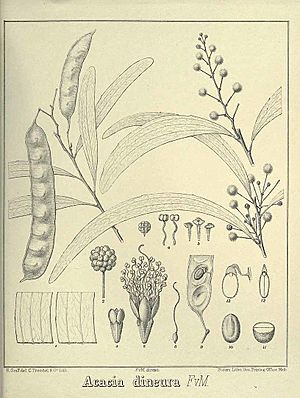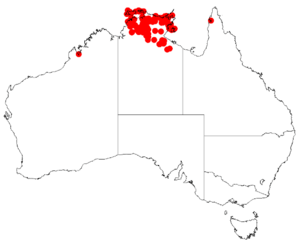Ball wattle facts for kids
Quick facts for kids Ball wattle |
|
|---|---|
 |
|
| A. latescens (as A. dineura) | |
| Conservation status | |
|
LC (TPWCA)
|
|
| Scientific classification | |
| Genus: |
Acacia
|
| Species: |
latescens
|
 |
|
| Occurrence data from AVH | |
| Synonyms | |
|
Acacia dissoneura F.Muell. |
|
Acacia latescens, often called Ball Wattle, is a type of tree. It belongs to the Acacia family, which is also known as Fabaceae. This tree grows naturally in the Northern Territory of Australia. You can find it commonly in the area called the Top End.
What it Looks Like
The Ball Wattle is a tree that grows between 4 and 9 meters tall. Its bark is brown and has cracks. The small branches are smooth and have ribs.
The leaves, called phyllodes, are smooth and curved. They can be from 8 to 26 centimeters long and 0.4 to 1.8 centimeters wide. Each leaf usually has two main veins, but sometimes it can have one or three.
The tree produces white or cream-colored flowers. These flowers grow in round clusters, about 4 to 6 millimeters wide. They appear from April to July.
After flowering, the tree grows greyish seed pods. These pods are straight and can be from 5 to 21 centimeters long. Inside, the seeds are dark brown to black. The tree produces fruit from August to January.
Where it Lives
You can find the Ball Wattle tree in many parts of the Northern Territory in Australia. It grows in areas like the Arnhem Coast and the Darwin Coastal region. It is also found in places such as Pine Creek and the Sturt Plateau.
Its Home
This tree usually grows in eucalypt woodlands. These are forests where eucalyptus trees are common.
How it Got its Name
The Ball Wattle was first described by a botanist named George Bentham in 1842. He studied a sample collected by Allan Cunningham. This sample was found on May-Day Island in 1818 during a trip by the ship HMS Mermaid.

